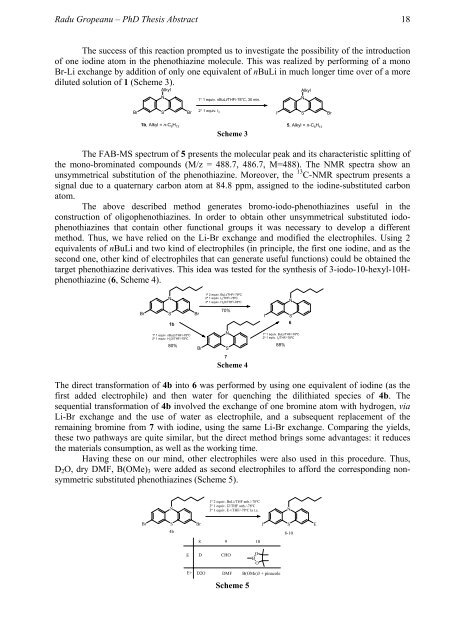Ph.D. THESIS ABSTRACT SYNTHESIS, STEREOCHEMISTRY AND ...
Ph.D. THESIS ABSTRACT SYNTHESIS, STEREOCHEMISTRY AND ...
Ph.D. THESIS ABSTRACT SYNTHESIS, STEREOCHEMISTRY AND ...
Create successful ePaper yourself
Turn your PDF publications into a flip-book with our unique Google optimized e-Paper software.
Radu Gropeanu – <strong>Ph</strong>D Thesis Abstract<br />
The success of this reaction prompted us to investigate the possibility of the introduction<br />
of one iodine atom in the phenothiazine molecule. This was realized by performing of a mono<br />
Br-Li exchange by addition of only one equivalent of nBuLi in much longer time over of a more<br />
diluted solution of 1 (Scheme 3).<br />
Alkyl<br />
N<br />
2° 1 equiv. I<br />
Br S<br />
Br 2<br />
I S Br<br />
1b, Alkyl = n-C 6 H 13<br />
1° 1 equiv. nBuLi/THF/-78°C, 30 min.<br />
Scheme 3<br />
Alkyl<br />
N<br />
5, Alkyl = n-C 6 H 13<br />
The FAB-MS spectrum of 5 presents the molecular peak and its characteristic splitting of<br />
the mono-brominated compounds (M/z = 488.7, 486.7, M=488). The NMR spectra show an<br />
unsymmetrical substitution of the phenothiazine. Moreover, the 13 C-NMR spectrum presents a<br />
signal due to a quaternary carbon atom at 84.8 ppm, assigned to the iodine-substituted carbon<br />
atom.<br />
The above described method generates bromo-iodo-phenothiazines useful in the<br />
construction of oligophenothiazines. In order to obtain other unsymmetrical substituted iodophenothiazines<br />
that contain other functional groups it was necessary to develop a different<br />
method. Thus, we have relied on the Li-Br exchange and modified the electrophiles. Using 2<br />
equivalents of nBuLi and two kind of electrophiles (in principle, the first one iodine, and as the<br />
second one, other kind of electrophiles that can generate useful functions) could be obtained the<br />
target phenothiazine derivatives. This idea was tested for the synthesis of 3-iodo-10-hexyl-10Hphenothiazine<br />
(6, Scheme 4).<br />
N<br />
Br S<br />
Br<br />
1b<br />
1º 1 equiv. nBuLi/THF/-78ºC<br />
2º 1 equiv. H 2 O/THF/-78ºC<br />
80%<br />
Br<br />
1º 2 equiv. BuLi/THF/-78ºC<br />
2º 1 equiv. I 2 /THF/-78ºC<br />
3º 1 equiv. H 2 O/THF/-78ºC<br />
70%<br />
N<br />
S<br />
7<br />
Scheme 4<br />
I<br />
N<br />
S<br />
6<br />
1º 1 equiv. BuLi/THF/-78ºC<br />
2º 1 eqiiv. I 2 /THF/-78ºC<br />
The direct transformation of 4b into 6 was performed by using one equivalent of iodine (as the<br />
first added electrophile) and then water for quenching the dilithiated species of 4b. The<br />
sequential transformation of 4b involved the exchange of one bromine atom with hydrogen, via<br />
Li-Br exchange and the use of water as electrophile, and a subsequent replacement of the<br />
remaining bromine from 7 with iodine, using the same Li-Br exchange. Comparing the yields,<br />
these two pathways are quite similar, but the direct method brings some advantages: it reduces<br />
the materials consumption, as well as the working time.<br />
Having these on our mind, other electrophiles were also used in this procedure. Thus,<br />
D2O, dry DMF, B(OMe)3 were added as second electrophiles to afford the corresponding nonsymmetric<br />
substituted phenothiazines (Scheme 5).<br />
N<br />
88%<br />
Br S<br />
Br I S<br />
E<br />
4b 8-10<br />
E<br />
E+<br />
1º 2 equiv. BuLi/THF anh./-78ºC<br />
2º 1 equiv. I2/THF anh./-78ºC<br />
3º 1 equiv. E+/THF/-78ºC la t.c.<br />
8 9 10<br />
D CHO<br />
O<br />
B<br />
O<br />
D2O DMF B(OMe)3 + pinacole<br />
Scheme 5<br />
N<br />
18

















